| 1 | Europe’s official longest snake |
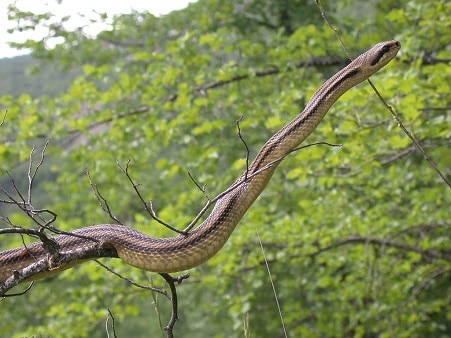
Europe has almost no venomous snakes capable of consistently killing someone, instead of just causing painful swelling or nausea. That said, there’s a handful large enough to cause a frantic debate as they bare their fangs at you, and one is the four-lined snake of Italy. This species averages at 1.5-1.8 metres, and reaches 2 metres in the largest females. The all-time record was 2.5 metres, making it the longest snake in Europe, beating the montpellier snake.
At birth, four-lined snakes measure 35cm. At year 1, they measure 45-55cm, and after 2 years they reach 65-75cm. Finally, they reach 1.2 metres after 4 years, and grow a few centimetres per year for the rest of their lives.
Fortunately, this length is purely for show: four-lined snakes have no venom and are incapable of hurting humans, constricting their prey to death instead. This is a simple snake to recognise in the wild, as their patterns consist of the namesake 4 stripes, with 2 on each flank. Their base colour is grey to yellow, while the lines themselves are jet black.
| 2 | Thousands of years ago |

Four-lined snakes have a long history, and one ancient tale involves Aesculapius, the Greek god of healing. Around 500BC, people began to worship him as a cult figure, and temples sprang up all over south-east Europe, with an important one being located in Epidaurus. Aesculapius was always sculpted with a snake draped around his neck, or being wielded as a rod, and many of these statues survive in Italy today.
The origin story goes that Aesculapius once saved a wild snake from an unspecified horrible fate. In return, the snake licked his ear clean, and whispered great knowledge into his ear while doing so.
For centuries, the actual species was assumed to be Zamenis longissimus, also found in Italy, and known colloquially as the Aesculapian snake. But recently, archaeologists have proven the species to have been the four-lined snake all along. Detailed paintings of the four-lined snake have been found in temples, as have paintings of Hydiea, Aesculapius’ daughter, bringing the loyal snakes a plate of eggs as food. The telltale evidence is that only four-lined snakes are confirmed to eat eggs, and not the Aesculapian snake.
| 3 | A healing snake |
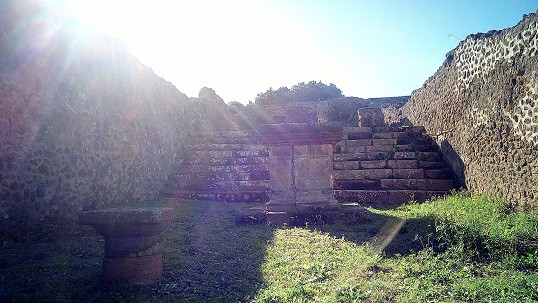
At the peak of the Roman empire, the cult of Aesculapius lived on, with his name evolving slightly to Asklepios. So did the temples, and all the snake-wielding statues inside them.
The goal of these temples was healing, and visitors would be ordered to make a sacrifice or offering in order to achieve ritual purification. Then they would enter an abaton or adyton, the holiest part of the sanctuary. Each of these contained dozens of snakes, which would slither all over the floor as the healing patients slept soundly (or attempted to). Again, these snakes were long believed to have been the Aesculapian snake, but were more likely the four-lined snake.
The Famous Roman writer Pliny had plenty to say as well, calling Elaphe quatuorlineata a calm snake which was perfect as a pet, which liked to eat eggs and was regularly transported to Rome from the grand healing temple in Epidaurus. Some folk rumours survive even today. The four-lined snake is believed to be a milk snake which grabs a cow’s udders, and squeezes the teet to extract the sweet milk within. Supposedly, they coil around cows’ legs in order to immobilise them. The slavic name of kravorcica translates to “cow snake”.
| 4 | Star of an annual festival |
Every March, residents of the Italian village of Cocullo gather for an elaborate snake festival. The origins are murky, but one belief is that during the 11th century, Saint Domenico cleansed the nearby fields of venomous snakes, causing the villagers to worship him every year from 1392 onwards. The ceremony starts on March 19th, when experienced snake charmers collect and defang snakes from the surrounding countryside. Some are Aesculapian or grass snakes, but the vast majority are the 2 metre long four-lined snake.
The villagers then ring the church bells with their teeth to bless themselves with good luck. The festival goers bless the nearby soil, which is later used as a pesticide to ensure a good harvest. Then they bring out the jewel-encrusted statue of Saint Domenico himself, and drape the still-living snakes around his neck like robes.
Finally, a procession of stony-faced priests and traditionally-dressed women parade the statue around town, complete with ceremonial cakes called ciaminitta with the texture of donuts. The procession takes 1.5 hours and begins at 12:00 on the dot, and ends when they return to the original church. The festival remains a booming tradition, and the streets are normally so crowded that movement is impossible (except for jumping on peoples’ heads). Animal activists need not fear, as the snakes are always released back into the wild.
| 5 | Habitat: rocks and crumbling buildings |
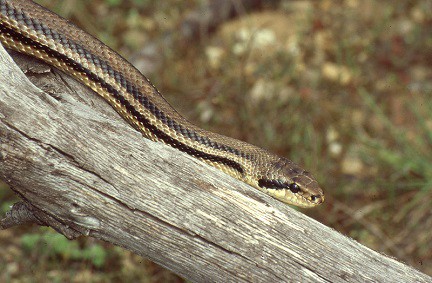
To the west, the four-lined snake is confined completely to Italy, never straying into Switzerland or southeast France. To the east, their range extends down to Greece, also including Croatia, Slovenia, Montenegro and Albania.
Within Italy, they inhabit the southern two thirds, excluding the southern islands such as Sicily. Their favourite habitats are semi-open areas, such as scree slopes on hills, bushy fields, brambly areas, and clearings adjacent to forests. It’s rare to find this snake in the thickest forests, and they have a particular affinity for rocks. The four-lined snake is often found sheltering beneath rocky rural walls, or crumbling, abandoned rural buildings (urban explorers beware!).
Four-lined snakes have no fear about crossing roads, and in 2017, one was rescued after getting its head stuck in the rusty metal delimiter of a rural road. It had slithered into the hole from a stray bullet, possibly after picking up the scent of a mammal which had previously taken shelter there.
| 6 | Combines swimming and climbing |
The four-lined snake is an excellent climber. They regularly ascend small tangled bushes, but also tall trees, where they snatch eggs from nests while mother birds are away on hunting expeditions. They’re equally strong swimmers, and are regularly filmed in water bodies thousands of times deeper than they are.
Their swimming technique involves S-shaped writhing of their bodies, propelling themselves forward through sheer will. The only part above water is their head, scanning the horizon for a route forward. Sometimes that route doesn’t appear, as in this video, a four-lined snake reached a black and white boat and became stuck, and was forced to skirt around the edges.
Elaphe quatuorlineata lays 6-18 eggs per batch, usually in autumn, which is about average for a ratsnake. Scientists have found that compared to another resident of Italy, the Aesculapian snake, individual four-lined snakes are very consistent in their egg totals. For example, if a mother snake lays 10 eggs at age 5, then she’ll probably lay the same amount each year for the next decade.
| 7 | Diet: rodents and some birds |
Like other ratsnakes, four-lined snakes have the power to eat eggs, and have a specially adapted column for crushing shells inside its body. However, they eat eggs comparatively less than their cousins such as the Japanese ratsnake. The bulk of its diet consists of rodents and birds. In a 1997 study from the Tolfa mountains near Rome, rodents and birds made up 77% and 23% of its diet respectively. The single most common prey species was the woodmouse (Apodemus sylvaticus).
The four-lined snake has a cyclical diet. The only period it eats birds is from April to June, and during these months, birds make up 75% of their prey. But when autumn rolls around, rodents jump to 100% of their diet.
Four-lined snakes have never been spotted eating lizards or other reptiles in adulthood. Lizards are the primary food source of younglings, but these specialised taste buds deactivate fully in adulthood. The longest four-lined snake ever spotted eating a lizard measured 89.4cm, versus an average adult length of 1.5-1.8m.
| 8 | Weasel royal rumble |
Four-lined snakes are a predator of the least weasel, one of the smallest mammalian predators in the known world, and in 2012 a savage battle was witnessed first hand. It took place in Istria, Croatia, in a small oak forest. It began when a student heard some faint squeaking sounds, after which the team discovered a four-lined snake with its body coiled around a least weasel, and its jaws gripping its head.
The weasel was far from defeated; it scratched the snake desperately with its free hind legs, causing bloody wounds. After struggling in snake’s coils, the weasel freed its head. Then it used the last card in its deck, and bit the four-lined snake hard inside its open mouth. The triggered a stream of blood, but the snake responded by reversing the weasel away from its vulnerable mouth and strengthening the constriction around its neck.
Over the next 15 minutes, the weasel slowly stopped twitching. Finally, the four-lined snake ate it headfirst, which took 6 minutes in total. From the first discovery of the duelling pair, it took 49 minutes for the snake to finally swallow the weasel.
| 9 | Defeated by a pet cat |
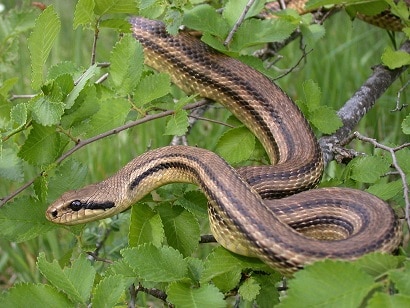
Another epic tail involving this snake happened on the Greek island of Corfu in 2011. Dick Mulder had watched as his pet cat Demon killed a four-lined snake on his porch, but soon his wife was screaming that the snake was still alive.
As he approached the corpse, Mulder saw a twitch, followed by a small Dahl’s whipsnake poking its head out of the dead snake’s mouth. Before long, the whipsnake had freed its entire body. Four-lined snakes generally eat their prey headfirst, yet this snake was somehow escaping head first. Experts believed that the Dahl’s whipsnake was just small enough to perform a U-turn in the depths of the larger snake’s stomach.
It was also still alive, the digestive juices having barely made an impact, so it must have only just been swallowed when Demon the cat struck. Fortunately, the Dahl’s whipsnake managed to avoid the cat’s claws itself as it fled the porch.
| 10 | A calm, patient snake |
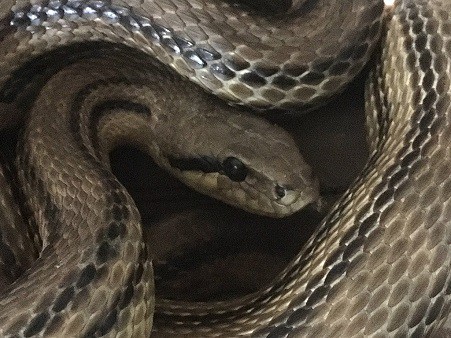
Four-lined snakes are a non-venomous species, but also bite relatively rarely compared to their aggressive neighbours like the green whipsnake. It’s rare for them to hiss loudly, or make the bizarre strangling noises of a coachwhip. Instead, the four-lined snake relies on its superior camouflage. It stays utterly still, allowing its subtle colours to blend in with tangled bushes or thick tufts of grass surrounded by rock.
Another example of their calm, patient nature lies in their diet. Four-lined snakes have a strong strategical brain, in that they always choose prey species well-suited to their size. They focus on smaller prey, even though their huge bodies could easily contain a garden rabbit or brown rat. Scientists found that their prey mass to body size averaged at 0.18 in Italy, compared to 0.36 for the viper family.
Four-lined snakes are a relatively non-adventurous snake, with a cosy home range which they become highly attached to. It’s rare for Elaphe quatuorlineata to travel 5km on an epic quest for new hunting grounds.
